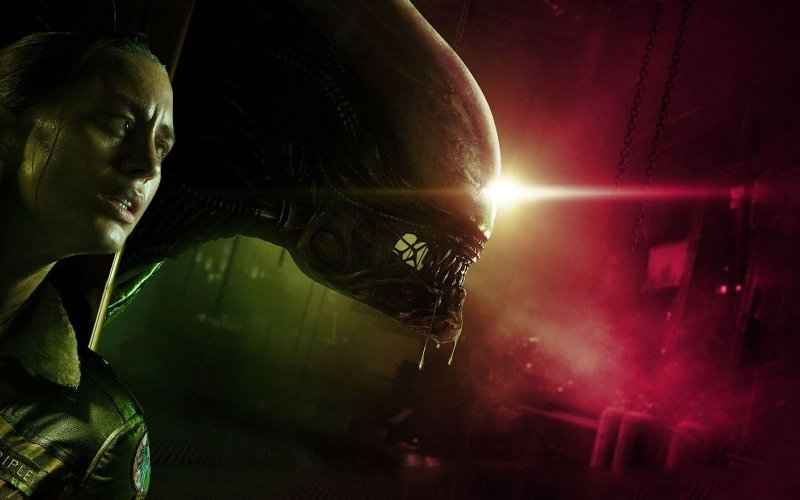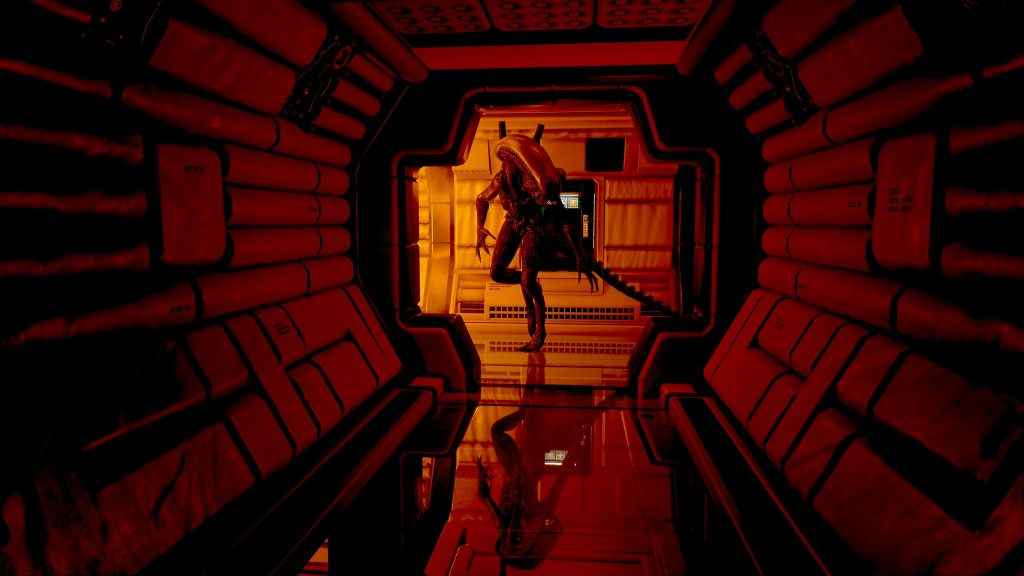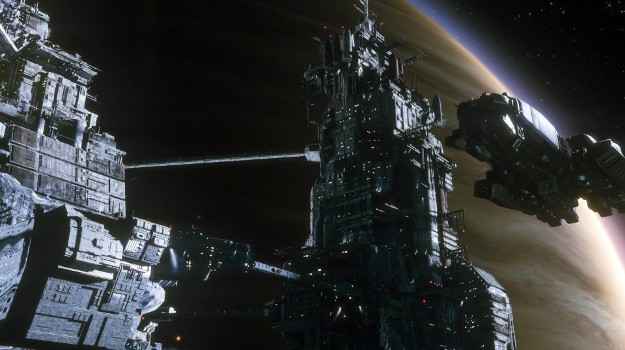In 1979, Ridley Scott and company introduced the world to Hollywood's most petrifying extraterrestrial, and we all know I'm not referring to Spielberg's kindly, soft-hearted E.T. but rather the heart-ripping endoparasitoid that invaded our nightmares for years to come. The Alien franchise would have no face without its beloved Xenomorph - a creature so ruthless, so savage that the mere mention of its hideous features will leave you peeking corners and hugging your nightlights, praying that it didn't hear you.
Though that won't matter, because the Xenomorph is insensitive to your plight and dread, and anyone familiar with the films is well aware of what can happen if it catches you in the hunt.
The Alien name has seen its fair share of poor video game adaptations, especially in recent years with the notorious Colonial Marines debacle. Some have said there's no hope for the franchise, but let it be known that Alien: Isolation goes beyond the milestone of redemption, easily serving as one of the most faithful film-to-game adaptations to date.
The famed Xenomorph has seen face time on many game consoles–spanning all the way back to the Atari 2600–but never has it stole the limelight like it does in Creative Assembly's authentic spin-off of the celebrated sci-fi thriller. While it evidently pays homage to the first film, Alien, how does it stand as a game in its own right?
The game puts you in the shoes of technician Amanda Ripley, the daughter of Ellen Ripley, the leading protagonist of the film series. Fast forward fifteen years from the events of the first movie and Amanda is avidly pursuing the whereabouts of her mother. Much to her fortune, she is approached by Weyland-Yutani executive Christopher Samuels about a flight recorder from the Nostromo–the towing spacecraft her mother was stationed on–which was discovered aboard a remote space station called the Sevastopol.
She is offered a place on the team being sent to retrieve it, but as you might expect, their arrival does not go as planned and everyone quickly gets separated. Once onboard the Sevastopol, you'll find that the atmosphere is eerily derelict, almost lifeless. From the get-go it doesn't take long to realize that something went horribly wrong.
Creative Assembly wastes little time showing off the laborious amount of research that went into creating its vast space station. Its overwhelmingly cold, metallic interior captures an architecture so akin to what's in the film that it's easy to mistake the Sevastopol for the Nostromo. Though not always as claustrophobic as its inspiration, with open spaces like lobby areas and transit stations, the similarities extend beyond structural design.
Inside you'll find even prop accuracy was met to a T with in-game computer monitors displaying old school vector graphics and bobbing water birds dipping their beaks away under a dim, lonesome light. Everything is meticulously detailed, and the thought and attention that went into reinvigorating this universe are passionately realized.
While the Sevastopol makes for a compelling character on its own, Ripley's supporting cast of colleagues alongside the inhabitants living within the station's corridors are not nearly as captivating in their conveyance. Their purpose and pathos is as empty as the deserted hallways that funnel through the ship itself. From the unhinged denizens to your trusty Wey-Yu crew, everyone is absolutely soulless and forgettable.
Emotionally intense moments are delivered like dry line-readings without purpose or understanding of what's happening in context of the moment. It's not overly off-putting, but it does kill the intensity of an ongoing manhunt when the line “I will shoot you” is spoken as if someone is buying fruits from the grocery store.
Some of the blame could be attributed to the substandard plot, which never amounts to anything stimulating. The game sports a generous fifteen-hour campaign, but the drawback is its inconsistent, lethargic pacing. You will experience broad stretches of gameplay where almost nothing is happening and the plot comes to an unwelcome standstill. This monotony is amplified by the wide array of mundane mission objectives that will give you nightmares about pressing buttons rather than the alien itself.
There's always some power generator that needs to be turned on, or some computer that must be accessed to unlock another area that will require you to fulfil the same sequence of events that you just labored through two missions ago. Sadly, most of the lore is tucked away in audio diaries and computer logs, giving the player a reason to explore the intricately constructed Sevastopol.
As I mentioned earlier, the game is heavily inspired by the first film, which truth be told, did not express a memorably invigorating plot either. Much of the film's praise came from its Hitchcockian approach to terror and suspense, a slant that kept the audience at the edge of their seats with absorbing sound design and entrancing visual composition.
Its secret was to spread the horror of what could not be seen and strike when the moment was right. At first the monster lives in your imagination–you see the monster you want to see–but then it reveals its true form, and just when you think you've gotten comfortable. I'm pleased to write that Alien: Isolation is no different in its tactics to crawl under your skin, and none other than the Xenomorph itself will do the honors of soiling your pants for you.
Unlike most survival horror games in recent memory, Isolation avoids the glorified haunted-house moniker that is plagued with scripted shock scare moments. The Xenomorph is not only frighteningly unpredictable, its ruthless free-roaming AI is one of gaming's most brilliant, predatory minds. Its scripted entrances are scarce, so expect many unexpected drop-ins that will leave you cowering in fear.
Sometimes it will happen right before your eyes, sometimes it will happen far along a corridor swallowed by utter darkness. You will hear it roar with a thirst for your blood, and all you can do is hide. Run, and it will catch you. Face it, and you're a fool to have tried. You'll spend a lot of time hiding in lockers or trembling underneath tables and desks. At first, it's easy to be fooled by the familiarity of this overused mechanic, but then the moment you expose yourself you hear it return, and you realize that it very well remembers where it heard you last.
Hiding under a desk for five minutes straight has never made me sweat this much. Seeing its serpentine tail slither by as it hisses its merry way to your impending doom won't ease the tension. Usually, in a game of this nature, it's easy to determine the right time to come on out and forget your fears, but in Isolation, it's never safe to come out. Your motion tracker is your best friend, but even the alien can outsmart your usage of it. The moment you walk out the door after hiding, don't be surprised if the alien drops in on you, and just when you thought the coast was clear.
Never assume it doesn't know where you are or else you'll get a hungry load of pharyngeal jaws to the face. So how do you defeat such an overpowered foe? Isolation refuses to grace you with such an option, but it will provide you with some tools that will aid you in your survival.
There are several tools and weapons at Ripley's disposal, which are all scattered around the Sevastopol waiting to be claimed. Don't roll your eyes just yet, because this is a survival horror game first and foremost, and Creative Assembly does not abandon this sentiment. Not only is ammo incredibly scarce, but the weapons you acquire are almost useless against the alien, with the exception of one weapon that might give it second thoughts about pouncing on you.
Ripley is an engineer, not a soldier. She doesn't know how to properly hold a weapon, let alone aim it, and this certainly reveals itself well in the gameplay. There is a proper weight to each weapon and her anxiety translates through her aim as she trembles with fear, always fidgeting with a weapon in hand. The crosshair on her pistol progressively shrinks and the kickback will force you to line up your shot again. In Isolation, you must make every shot count.
You will also find blueprints for items that you can craft. Crafted items range from smoke bombs to noisemakers, and these will be your saving grace when seeking to escape the threat. You'll find parts and components hidden in chests, drawers, and cupboards. To craft something you'll open up a radial menu, select an item, and end your assembly by choosing its parts, all in real time.
It's very simple and accessible; I'd even compare it to the crafting system in The Last of Us. But what is the purpose of these devices if the Xenomorph is immune to its effects? The alien is not your only enemy onboard the Sevastopol, and sometimes you'll find it better to toss an explosive for the sake of guiding your evasion rather than tackling violence head-on.
The game is clearly at its weakest when its parasitic stud is out of your hair. You'll encounter human factions that want you dead, which you can opt to wipe out yourself or just sneak around them and avoid confrontation. Combating them straight on never seems like the wisest option, especially considering that every Tom, Dick, and Harry knows how to shoot you directly in the face, even from the furthest distance. I questioned this logic, seeing how most human foes are paranoid, feeble survivors who likely cannot aim a weapon any better than Ripley can.
You'll also come across Working Joe androids that are much more difficult to take down. You cannot use them as bait for the alien and their synthetic armor makes them less vulnerable to your weapons. On the flipside, their cone of vision is narrow and they're quite slow, so dodging them is usually never a problem. Nothing poses a threat like the Xenomorph does, so when it's not around, things get a bit stale.
Thankfully, the game's setting is so immersive, so brimming with tension, that sometimes you can forgive the campaign's faults. The dim lighting bathes the Sevastopol with a cold, dead look. The sound design is remarkably executed, always keeping you on your toes with the rustling of alien movement in the vents and the echoing of screams and gunshots occurring somewhere nearby.
Creative Assembly even pays tribute to the iconic blaring of the alarm system from the film. Come to the end of your playthrough, you'll hear the head-pounding bleep of the motion-tracker in your sleep, praying that the alien isn't hiding under your bed.
Everything is incredibly atmospheric, and it all looks stunning on PlayStation 4. But the game is not void of performance issues and visual hiccups. The frame rate is unacceptably low during cutscenes, so much so that I reset my PS4 the first time I witnessed it under the assumption that it could have been my system. The game's lip-syncing is also a bit comical, but then again, so is the voice acting. You'll also run into some occasional clipping, but it's nothing too serious.
When all is said and done, Alien: Isolation is a well-crafted product with a handful of flaws that are merely forgivable. It's not a game for everyone. It's dreadfully challenging and you must be open to the concept of persistent, continual death. It will require patience, cunning, and of course, a brave spirit. In its purest form, it's the closest thing to a proper AAA survival horror title in recent years.
With a little more elbow grease and attention to storytelling, Creative Assembly holds the blueprint to a potentially explosive creation–one that not only impresses on its own merits but also remains loyal to its source material. Alien is back, but this time you're the prey, not the spectator.





